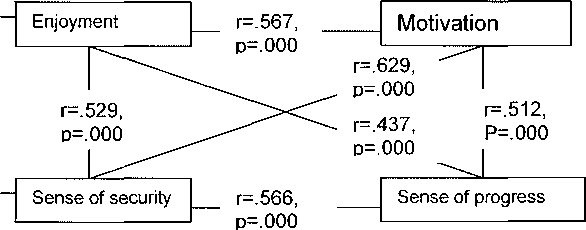161
Individual work
Figure 4.5.17: Relationships between attitudes to mathematics learning as promoted by
Individual work: perceptions of 5th grade teachers
|
Enjoyment |
------- r=.656, p=.000 --------- |
Motivation | |
|
Sense of security |
r=.555, p=.000 |
Sense of progress | |
Figure 4.5.17 shows that compared with the previous teaching methods examined the
relative lack of relationships for Individual work is marked. The only positive relationships
for 5th grade teachers were between enjoyment and motivation, and sense of security
and progress. For 8th grade teachers, pupils’ enjoyment and motivation, and motivation
and sense of progress promoted by Individual work were correlated. In contrast with the
relationships outlined earlier the impact of Individual work on pupils attitudes was not
seen as integrated (see Figure 4.5.18 in appendix). For the pupils at 5th grade, there
were significant moderate positive correlations between the effects on the four attitudinal
aspects as promoted by Individual work. These were also related to the extents that the
method were perceived to be deployed.
Figure 4.5.19: Relationships between attitudes to mathematics learning as promoted by
Individual work: perceptions of 5th graders
Deployment

161
More intriguing information
1. Learning-by-Exporting? Firm-Level Evidence for UK Manufacturing and Services Sectors2. The name is absent
3. The name is absent
4. GENE EXPRESSION AND ITS DISCONTENTS Developmental disorders as dysfunctions of epigenetic cognition
5. The name is absent
6. The name is absent
7. The Complexity Era in Economics
8. Firm Creation, Firm Evolution and Clusters in Chile’s Dynamic Wine Sector: Evidence from the Colchagua and Casablanca Regions
9. Optimal Private and Public Harvesting under Spatial and Temporal Interdependence
10. The technological mediation of mathematics and its learning